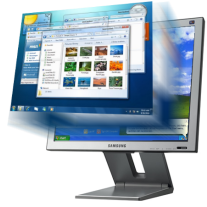Windows XP Mode for dummies


To put it simply (as possible, it's not easy), Windows 7 runs as your main, host operating system. You have the option of having a virtual, free copy of Windows XP silently running in the background. This can be called upon when you have an application which doesn't work in Windows 7.
And instead of fiddly compatibility tools that may or may not work with your old application, you can run it using your virtual copy of Windows XP. The application then runs seamlessly as if it was running in Windows 7, but is actually being projected onto your screen from the virtual Windows XP copy in the background.
See, not too bad of an explanation, really?
To break it down a little further so you can see what is going on, imagine the same projection analogy. Windows XP Mode simply allows older or legacy applications to be projected from the behind-the-scenes Windows XP copy onto your Windows 7 desktop. You don't actually see anything of Windows XP except the blue user interface you are all used to, so it's not like you have to physically manage two operating systems.
First off, you better make sure that your Windows 7 version can support it. If you have downloaded the release candidate, you're running Ultimate which will work just fine. You start off by downloading and installing Windows Virtual PC, which is the new virtual environment optimised perfectly for Windows 7, and the Windows XP components, which is essentially a fully configured copy of Windows XP. After installation, you need to set up your virtual machine, and your virtual Windows XP is only a double click away from the Start menu.
While this may sound a bit out of your league, it really is easy to set up. Microsoft are aware that this will be a fantastic solution to many of the compatibility issues and has adjusted the setup to be easy to read and very user friendly.
Once you are set up, you will go through a number of options, similar to an ordinary Windows XP setup. After all this, your virtual Windows XP desktop will be displayed to you. There's no need for activation because it simply doesn't need it.
What isn't made very clear is how to virtualise your legacy applications to run in your virtual Windows XP machine, but be accessible from Windows 7. It's relatively simple once you find the documentation. Simply install the legacy applications which don't work on Windows 7 to your virtual Windows XP machine, and they will magically appear in your Windows 7 Start menu once you have closed the virtual machine down.
Once you select an application to open, your virtual machine will be closed down. This is perfectly normal and how it should operate, so don't panic when you see your virtual machine initialised.
After this point, you will most likely start to feel more confident in what is going on; I most certainly did. You will notice a few changes to how your applications work. Each application which is running in Windows XP Mode has the same icon with an added smaller icon to tell you of the fact. Also, tooltips remind you by adding (Remote) after the application's name.
From here, you will notice your legacy applications running seamlessly in Windows 7 but with a Windows XP theme. It really is fantastic to use once you get going.
For those familiar with the administration console in Windows Home Server, this is the same technology being used. You can access the Windows Home Server administration console from any Windows machine, and in its own dedicated window, and shows nothing other than the console - even though the rest of the operating system is running left, right, center and behind the console.
Again, it works entirely on a projection principle which is why when you shake the virtualised application around on your desktop quickly, you see the projector screen - the blue bit around the application.
If you have any questions, feel free to leave them in the TalkBack section and I'll give answering them a go. Remember, I may well be able to explain Windows XP Mode, but I can't solve the world's problems and most certainly not the more colourful ones you throw me.